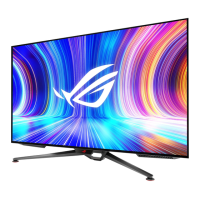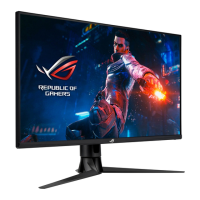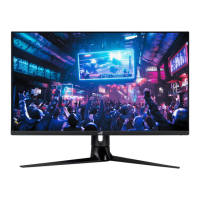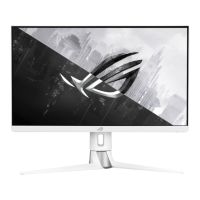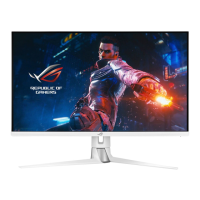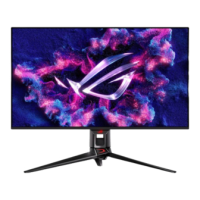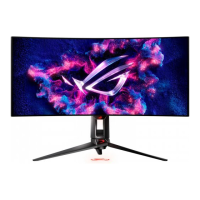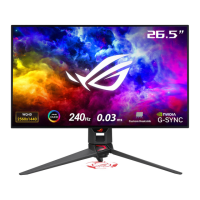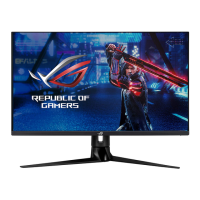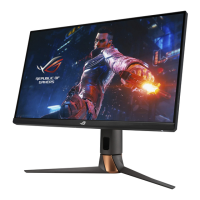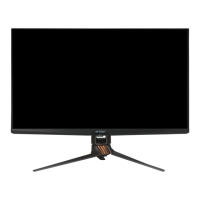Do you have a question about the Asus ROG SWIFT PG48UQ and is the answer not in the manual?
Welcome message and list of items included in the monitor package.
Details monitor's front and back views, controls, and ports.
Explains the operation of the monitor's remote control buttons.
Describes GamePlus overlays and GameVisual display modes for gaming.
Instructions for attaching and detaching the monitor stand, including VESA compatibility.
Guidance on organizing cables and connecting display, power, and audio interfaces.
Steps to power on the monitor and understand the power indicator status.
How to navigate the On-Screen Display (OSD) menu and adjust settings.
Configuration options for Gaming, Image, Color, Input, PIP/PBP, MyFavorite, and System Setup.
Detailed specifications including panel type, resolution, dimensions, and compliance.
Solutions for common problems like power, display, image defects, and HDR content.
Lists compatible resolution and refresh rate combinations for HDMI and DisplayPort.
| Panel type | - |
|---|---|
| Color gamut | 98 % |
| Pixel pitch | 0.27405 x 0.27405 mm |
| Screen shape | Flat |
| Response time | 0.1 ms |
| Display surface | Matt |
| Display diagonal | 47.53 \ |
| Display technology | OLED |
| Native aspect ratio | 16:9 |
| Maximum refresh rate | 138 Hz |
| Viewable size, vertical | 591.84 mm |
| sRGB coverage (typical) | 133 % |
| Contrast ratio (dynamic) | 1500000:1 |
| Contrast ratio (typical) | 135000:1 |
| Display number of colors | 1.073 billion colors |
| Viewable size, horizontal | 1052.16 mm |
| Digital vertical frequency | 48 - 138 Hz |
| Digital horizontal frequency | 30 - 311 kHz |
| Display brightness (typical) | 450 cd/m² |
| High Dynamic Range (HDR) supported | Yes |
| High Dynamic Range (HDR) technology | High Dynamic Range 10 (HDR10) |
| Dynamic contrast ratio marketing name | ASUS Smart Contrast Ratio (ASCR) |
| HDCP version | 2.3 |
| HDMI version | 2.0/2.1 |
| USB hub version | 3.2 Gen 2 (3.1 Gen 2) |
| Headphone outputs | 1 |
| DisplayPort version | 1.4 |
| USB Type-A downstream ports quantity | 4 |
| Tilt angle range | -5 - 5 ° |
| Cable lock slot type | Kensington |
| Panel mounting interface | 300 x 300 mm |
| AC input voltage | 100 - 240 V |
| AC input frequency | 50 - 60 Hz |
| Energy efficiency scale | A to G |
| Power consumption (standby) | - W |
| Power consumption (typical) | 300 W |
| Power consumption (PowerSave) | 0.3 W |
| Smart modes | Game |
| NVIDIA G-SYNC type | G-SYNC Compatible |
| RMS rated power | 20 W |
| Number of speakers | 2 |
| Product color | Black |
| Market positioning | Gaming |
| Package type | Box |
| Package depth | 180 mm |
| Package width | 1230 mm |
| Package height | 880 mm |
| Package weight | 20000 g |
| Depth (with stand) | 266 mm |
|---|---|
| Width (with stand) | 1068 mm |
| Height (with stand) | 686 mm |
| Weight (with stand) | 16200 g |
| Depth (without stand) | 40 mm |
| Height (without stand) | 612 mm |
| Weight (without stand) | 15000 g |
